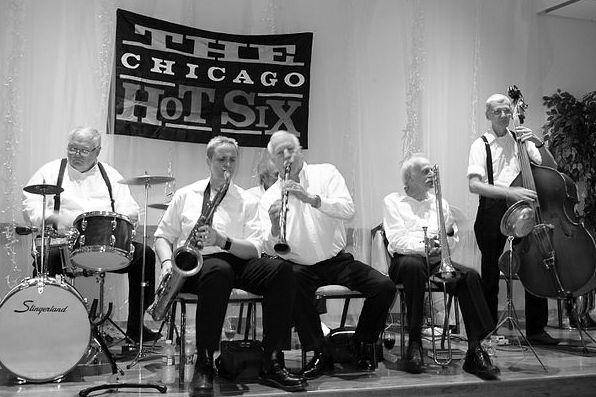When the Chicago Hot Six takes the stage, you never know what you’ll hear!
Could be the spiritual “Lead Me Savior” or the multi-strain ragtime tune “Weary Blues” or Kid Ory’s “Panama Rag.” Could be the raucous Sarah Spencer singing “Make Me a Pallet on the Floor.” It could be a swaggering version of “Bogalusa Strut.”
“We aim for a very old New Orleans sound,” says bandleader/trombonist Roy Rubinstein. “That’s the music I most enjoy playing and listening to and it’s really the most authentic jazz.”
Bandleaders shouldn’t hold fast to any totally pre-set plan, especially when the choices are so marvelous and so many. “We’re always drawing from a much larger repertoire than what you’ll actually hear,” Roy says. Then the band tailors its set list to fit its listeners.
A quick glimpse at Hot Six discs shows that the combo eschews evergreens in favor of less-commonplace tunes. “Right,” said Rubinstein, “It’s not the usual stuff. We’re inclined to play more obscure New Orleans tunes. That’s more interesting for the audience and more interesting for us as well.”
Unusual tunes
Some of the sextet’s more atypical tunes are the spiritual “Lead Me Savior” and Artie Matthews’ 1915 multi-strain ragtime composition “Weary Blues” first recorded in 1919 by Yellow Nunez & The Louisiana Five and often known by its other name “Shake It and Break It.”
Other Chicago Hot Six specialties include “Bugle Boy March,” a tune based on “The American Soldier,” and “Panama Rag” recorded in 1923 by Kid Ory’s Creole Orchestra. Every now and then, the Hot Six will jam for six and a half minutes or more on “Special Delivery Blues.”
“But never fear,” Rubinstein said, “we’ll also play some tunes that people are familiar with,” numbers such as “Swing That Music” or “Mobile Blues.”
Head arrangements
“We lean toward tunes that the audience seems to enjoy,” Rubinstein said. “When you’re a leader you don’t want a totally pre-set idea of what you’re going to play. We’re always drawing from a much larger repertoire than what you’ll actually hear.” Then the band tailors its set list to fit the occasion and its listeners. All of the group’s tunes are head arrangements. They don’t use charts.
The Chicago Hot Six features Roy Rubinstein on trombone, Sarah Spencer on tenor saxophone and vocals, John Skillman on clarinet, and a rhythm section of banjoist John Kuncl, bassist Art Hovey, and drummer Mike Albiniak. The sextet has no trumpet or cornet player.
“In the more than 30 years that this band and its predecessor existed, we’ve had only two trumpet or cornet players,” the bandleader said. “One died after many years with the band, and the other retired from music and moved away from the Chicago area, again after many years with the band. So far we haven’t found anyone else who fits in so well with the style of jazz that we play, so we started to play without a trumpet player, and we liked the sound.”
While the musicians all take leads, the bandleader stresses ensemble work. “I much prefer playing ensembles, two people playing together, that sort of thing,” he said.
British beginnings
Although he lives and works in the Windy City, Rubinstein is far from a Midwesterner. He was born and raised in Darlington in Northeast England. He took piano lessons at age 10, but dropped them after a year or two.
“I became interested in traditional jazz at about age 16, and bought an alto saxophone since I wanted to make music, not just listen to it, then soprano sax, then clarinet and finally trombone.” He settled on the ’bone when he went to college because, he said, “there were many good clarinetists there and very few trombone players.”
When Roy was a teenager, trad jazz was very popular in England. “Trad tunes were always in the Top 20,” he recalled, mentioning artists such as trombonist Chris Barber and clarinetist Acker Bilk whose retro-jazz records sold millions of copies.
“That lasted, oh, a half-dozen years or so,” Roy said. “Fads take over.” Once The Beatles arrived on the pop music scene, it was over.
Kid & Big Jim
After moving to the United States, Rubinstein took a job at Cornell University as an assistant professor of physics in the early 1960s. While in Ithaca, he joined a Dixie group called the Muskrat Ramblers. Roy left Cornell for Long Island in the mid-60s, and in 1973 he moved to Chicago where he worked a day job as a nuclear physicist.
Rubinstein cites two primary musical influences: trombonists Kid Ory and Big Jim Robinson.
“I heard both of them live when they toured in England when I was a teenager and later saw Robinson at Preservation Hall a few times,” he recalled. “Both were very rhythmic players who bridged the gap between the rhythm section and the frontline. They really pushed the frontline in a rhythmic fashion, and that’s the style I like.”
Russ Tarby is based in Syracuse NY and has written about jazz for The Syncopated Times, The Syracuse New Times, The Jazz Appreciation Society of Syracuse (JASS) JazzFax Newsletter, and several other publications.






















